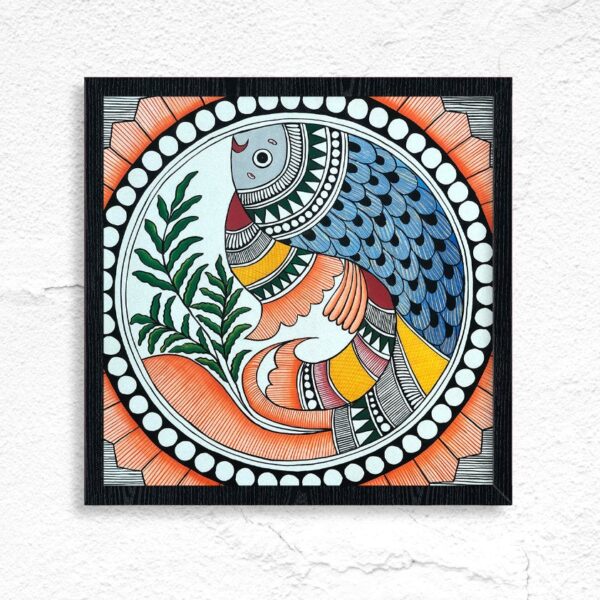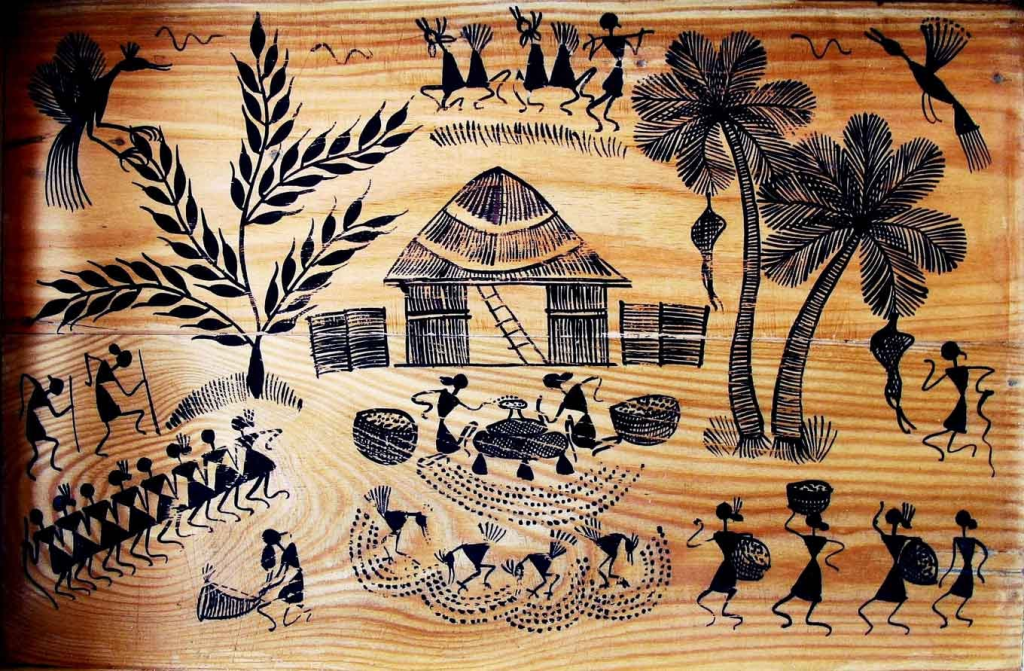Embark on a colorful journey into the heart of Indian traditional folk art painting. Immerse yourself in the rich tapestry of culture, history, and vibrant expressions encapsulated in these timeless artworks. Explore the diversity of styles, techniques, and stories behind each stroke, capturing the essence of India’s artistic heritage.
India, a land of diverse cultures and rich heritage, is a treasure trove of art forms that beautifully reflect its traditions, beliefs, and way of life. Among these art forms, traditional folk art paintings stand out as vibrant and captivating expressions of the country’s cultural tapestry. These paintings are not just artistic creations but windows into the soul of various Indian communities, encapsulating their stories, rituals, and aspirations. In this blog, we’ll take a fascinating journey through the world of Indian Traditional Folk Art Painting, exploring its regional diversity, techniques, themes, and enduring significance.

Regional Diversity of Indian Traditional Folk Art Painting
India’s vast geographical expanse has given rise to an astonishing array of traditional folk art forms, each reflecting the distinct identity of the region it originates from. Let’s delve into a few prominent styles:
- Madhubani Painting (Bihar):
Originating from the Mithila region of Bihar, Madhubani painting is characterized by intricate patterns, bold lines, and bright colors. These paintings often depict mythological stories, nature, and social events. The use of symbolic elements and geometric designs makes this art form truly unique.
- Warli Painting (Maharashtra/Gujarat):
The Warli tribe, residing in the western states of Maharashtra and Gujarat, has a distinctive style of painting. Warli art is minimalist, primarily using white pigment on a brown background. It features simple geometric shapes to depict human figures, animals, and scenes from everyday life.
- Pattachitra (Odisha/West Bengal):
Pattachitra is a traditional art form from Odisha and West Bengal, known for its intricate detailing and vibrant colors. These paintings often illustrate stories from Hindu mythology and depict deities, historical events, and folk tales. The use of cloth as a canvas adds a unique texture to the artwork.
- Rajasthani Miniature Painting (Rajasthan):
The desert state of Rajasthan is famous for its intricate miniature paintings. These paintings are characterized by their detailed brushwork and exquisite portrayal of subjects. Themes range from historical events to portraits of nobility, hunting scenes, and depictions of love.
Techniques and Materials
Indian traditional folk art paintings are often created using natural materials and techniques passed down through generations. The materials used vary depending on the region, but they usually include items readily available in the local environment.
- Natural Pigments:
Artists use pigments derived from natural sources such as plants, minerals, and even cow dung. These pigments produce the distinct earthy and vibrant tones that are characteristic of folk art.
- Brushes:
Brushes are made from materials like twigs, animal hair, or natural fibers. These brushes are used to create intricate designs and patterns, with each style having its own brush requirements.
- Canvas:
The canvas for these paintings can range from fabric and paper to walls and floors. Some art forms, like Warli painting, are traditionally created on mud walls.
- Outlines and Fillings:
Many folk art styles emphasize bold outlines, which are often created using a thick paste made from rice, chalk, or natural pigments. The outlines are then filled with vibrant colors.
- Symbolism:
Symbolism plays a significant role in traditional folk art. Various shapes, motifs, and colors hold deeper meanings related to cultural beliefs, rituals, and social contexts.
Themes and Significance
Indian traditional folk art paintings are more than just visual delights; they serve as mediums to communicate stories, beliefs, and values.
- Mythology and Religion:
Many folk art paintings depict stories from Hindu mythology, showcasing the exploits of gods and goddesses. These paintings also play a role in religious rituals and festivals.
- Everyday Life:
Scenes from daily life, such as farming, village festivities, and household chores, are commonly depicted in these paintings. They capture the essence of rural existence and provide insights into traditional ways of living.
- Nature and Environment:
Nature holds immense importance in Indian culture, and this reverence is reflected in folk art. Animals, trees, and landscapes are often depicted, sometimes with spiritual or symbolic connotations.
- Social and Cultural Commentary:
Folk art can also be a medium for social commentary. Issues such as gender roles, community dynamics, and societal changes find expression through these art forms.
Enduring Significance
Indian traditional folk art paintings hold a unique place in the world of art and culture. Despite the changing times and the advent of modern techniques, these art forms continue to thrive. They provide a connection to India’s roots, preserving the stories and traditions of various communities. Moreover, they have gained international recognition, becoming symbols of India’s rich cultural heritage.
In recent years, efforts have been made to promote and sustain these art forms. Workshops, exhibitions, and collaborations with contemporary artists have helped bring these traditional styles into the mainstream art scene, ensuring their relevance for future generations.

Conclusion :
Indian traditional folk art paintings are a testament to the country’s diverse cultural mosaic. Through their vibrant colors, intricate patterns, and symbolic representations, they offer glimpses into the history, beliefs, and lives of different communities. These paintings are not just artistic expressions; they are windows into the heart and soul of India’s people. As we continue to navigate the complexities of the modern world, these art forms remind us of the beauty and depth of our cultural heritage. It is our responsibility to cherish, preserve, and pass on these treasures to the generations that follow, ensuring that the stories of India’s past continue to illuminate its future.
